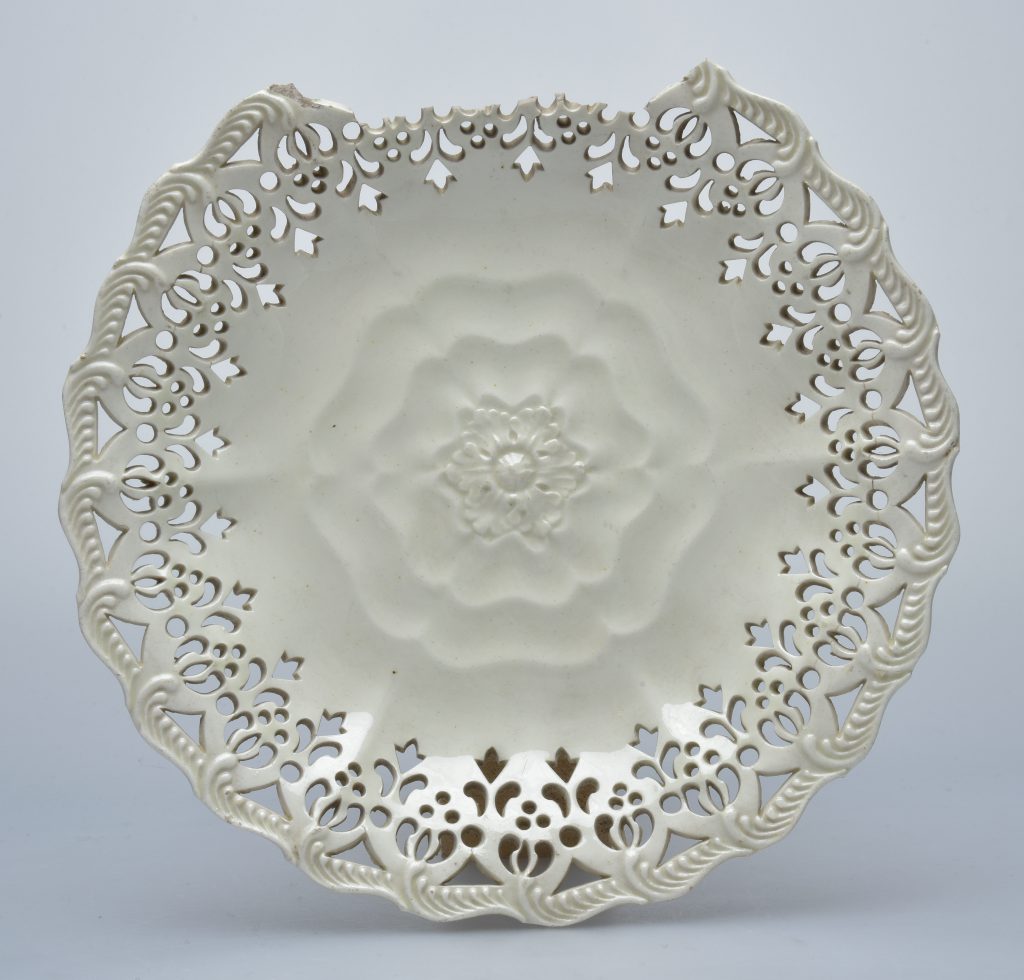
Creamware (refined white earthenware) in CERAMICA CH
Creamware is one of many types of English pottery that were developed from the earlier white salt-glazed stoneware in Staffordshire in England in the early 1740s and subsequently perfected by Josiah Wedgwood (c. 1759-1761) to create “cream-coloured ware”. In German usage, creamware (from 1765 Josiah Wedgwood’s ceramics were also known as “Queen’s ware”) is termed “Steingut”.
From a technical perspective, creamware is lead-glazed, porous earthenware made from clay that when fired becomes white and contains kaolin and SiO2 (quartz, often powdered flint); it can also contain just lime or feldspar or a mixture of all three components (quartz, lime and feldspar). Depending on the date and time of production, the composition of the clay body can vary greatly.
Due to the colour and matrix of its fabric, creamware is also known as “weisse Irdenware” – “white earthenware, white-bodied industrial earthenware, refined white eartenware” – “terres blanches”. Because it was manufactured in dedicated industrial plants, refined white earthenware in all its forms is also known as “industrial pottery” or “industrial fineware”.
By adding cobalt to the cream-coloured or yellowish clay body of “creamware”, English potters in the early 19th century developed a white variant known as “whiteware”. “China glaze” (Staffordshire c. 1775) or “pearl-white” (Josiah Wedgwood around 1779), where a small amount of cobalt was added to both the ceramic body and the glaze, making creamware seem slightly “whiter” and less cream-coloured and thus more similar to porcelain, were intermediate steps between the two. Today these variants are subsumed under the term “pearlware”.
The French evolution of creamware or “terre façon anglaise”, “terre de pipe”, “terre d’Angleterre” or “cailloutage” as it was known at the time, also began in the early 1740s. In French contemporaneous parlance, the terms “terre de pipe” (c. 1743-1790), “cailloutage” (c. 1790-1830) and “porcelaine opaque” or “demi-porcelaine” (after 1830) superseded each other.
Translation Sandy Haemmerle
German: Steingut
French: céramique industrielle, faïence fine, terre façon anglaise, terre de pipe, terre d’Angleterre, cailloutage, porcelaine opaque, demi-porcelaine, poterie blanche
References on the definition, terms and synonyms of creamware:
Barker 2007
David Barker, Creamware in Context, in: Tom Walford/Roger Massey, Creamware and Pearlware Re-examined, Beckenham 2007, 31-42.
Bartels 1999
Michiel Bartels, Steden in Scherven, Zwolle 1999, bes. 250-259
Kybalová 1990
Jana Kybalová, Steingut, Prag 1990.
Maggetti/Rosen/Serneels 2011
Marino Maggetti/Jean Rosen/Vincent Serneels, White earthenware from Lorraine (1755- c. 1820): Provenance and Technique, in: Archaeometry 53, 2011, 765-790.
Maggetti/Heege/Serneels 2015
Marino Maggetti/Andreas Heege/Vincent Serneels, Technological Aspects of early 19th c. English and French white earthenware assemblage from Bern (Switzerland), in: Periodico di Mineralogia, 84, 2015, Heft 1 (Special issue: EMAC 2013, Inside the pottery: composition, technology, sources, provenance and use), 139-168.
Maggetti 2018
Marino Maggetti, Archaeometric Analyses of European 18th-20th Century White Earthenware – A Review, in: Minerals, 2018, Heft 8.
Maire 2008
Christian Maire, Histoire de la faïence fine francaise 1743-1843, Le Mans 2008, 11-36.
Massey 2007
Roger Massey, Understanding Creamware, in: Tom Walford/Roger Massey, Creamware and Pearlware Re-examined, Beckenham 2007, 15-30.
Roberts 2007
Gaye Blake Roberts, Early Wedgwood Creamware 1759-1769, in: Tom Walford/Roger Massey, Creamware and Pearlware Re-examined, Beckenham 2007, 51-64.
Stellingwerf 2019
Wytze Stellingwerf, The Patriot behind the pot. A historical and archaeological study of ceramics, glassware and politics in the Dutch household of the Revolutionary Era: 1780-1815, Zwolle 2019, bes. 42-51, 202

